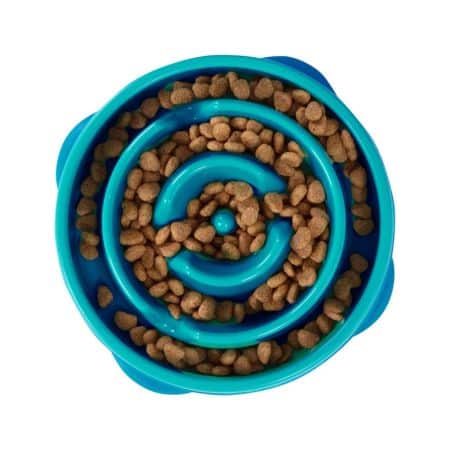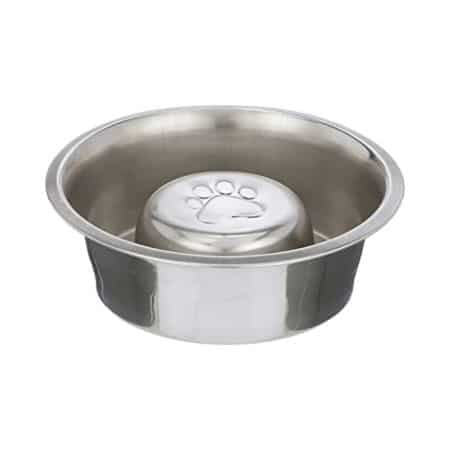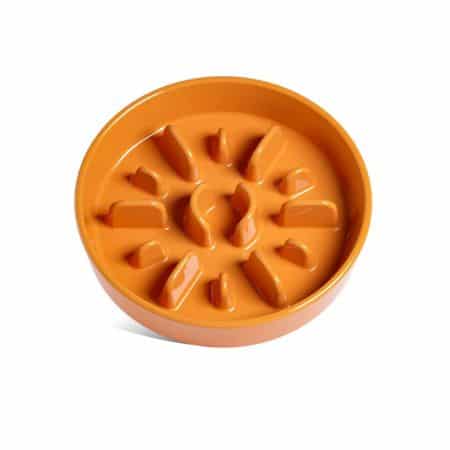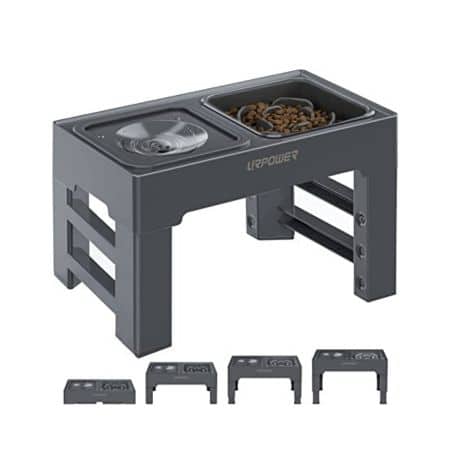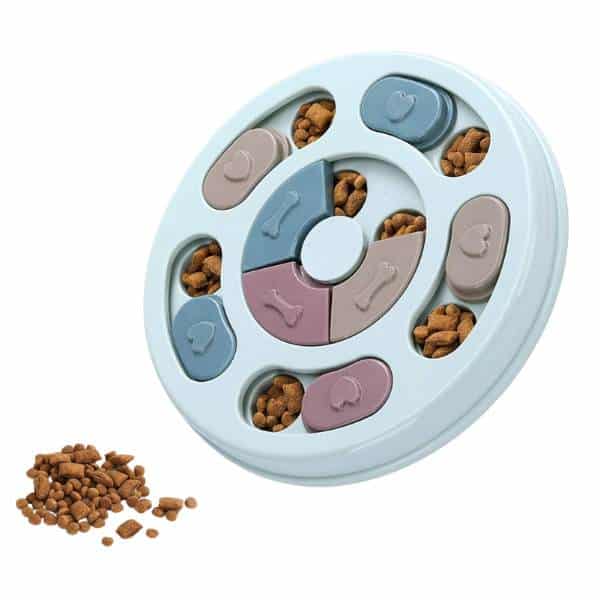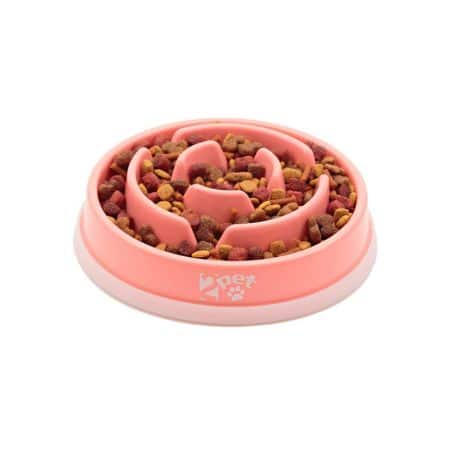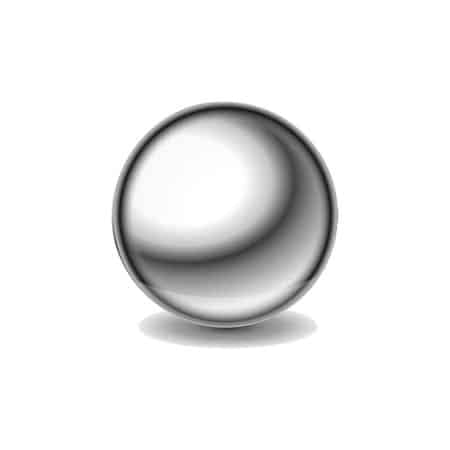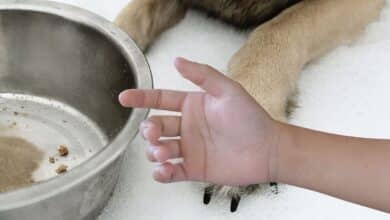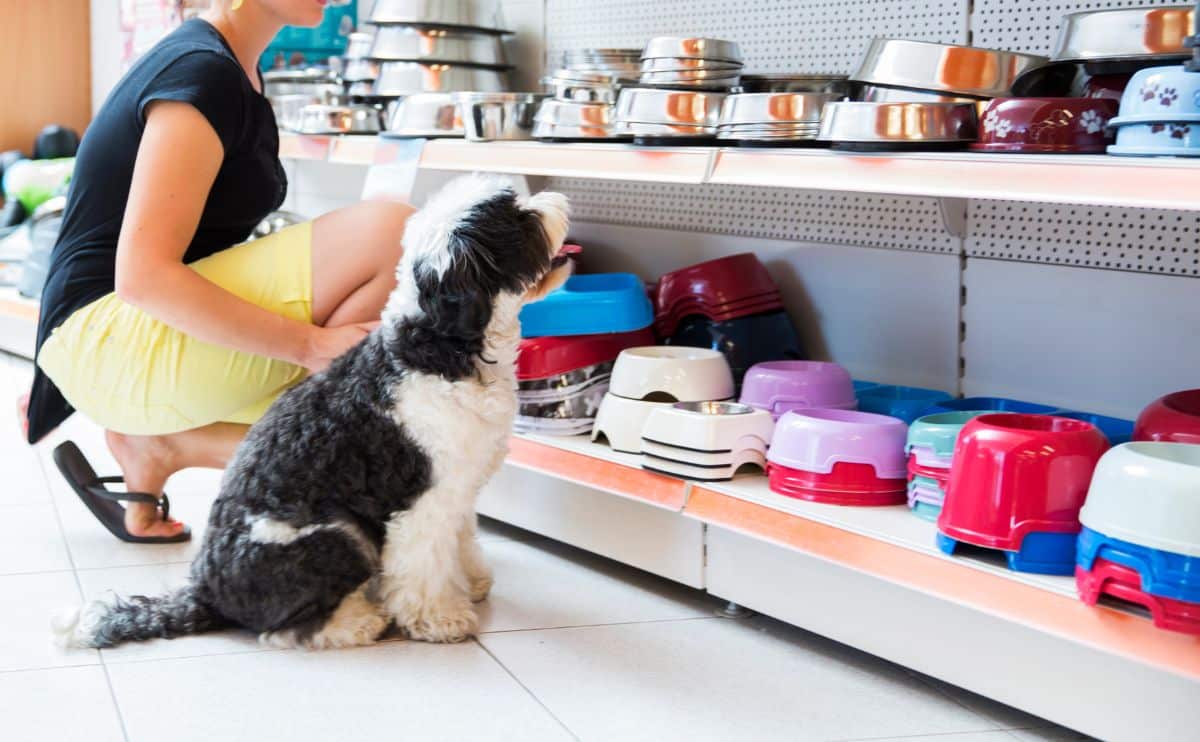9 Best Slow-Feeder Dog Bowls: Puzzle Feeder, Ball & More (35+ Tested)
When you purchase through links on our site, we may earn a commission. Here’s how it works.
Does your dog gobble up every meal like they have never seen food before? If you, like me, have a dog that always eats too fast, you may wonder if there is any way to slow them down. Learn more about slow-feeder dog bowls, how they work, and if one might be right for your pup. I’ll share some top picks and our personal experience with the best slow-feeder dog bowls.
Table of Contents
| Top Pick | Puzzle Feeder | Ceramic | Slow Feeder Ball |
|---|---|---|---|
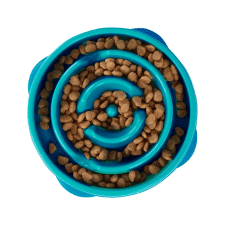 |  | 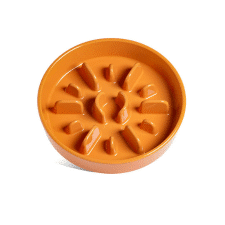 | 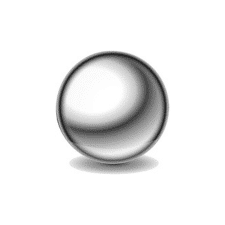 |
| Outward Hound Fun Feeder Slo Bowl | DR CATCH Puzzle Feeder | LE TAUCI | KUNWU |
| View on Amazon | View on Amazon | View on Amazon | View on Amazon |
| Read Review | Read Review | Read Review | Read Review |
What Is A Slow-Feed Dog Bowl?
As if the name wasn’t a dead giveaway, a slow-feed dog bowl is designed to do one thing:
Stop your dog from eating too quickly.
How do slow-feed dog bowls achieve that? Well, it’s actually quite clever – the bowl features raised sections that prevent your dog from eating his food all at once. Without easy access to his food, your dog can only eat small amounts at a time, extending his mealtime. The exact arrangement of these raised sections varies from bowl to bowl.
Some have spirals:
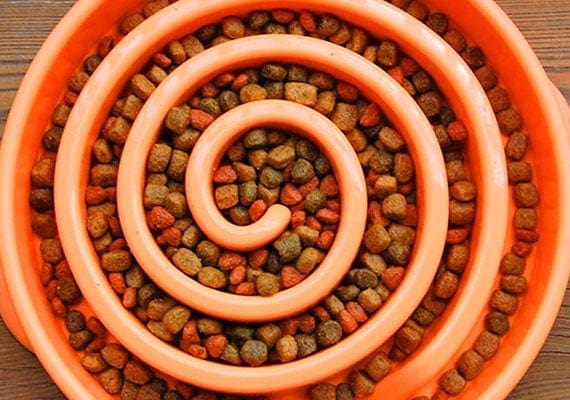
Others have humps:
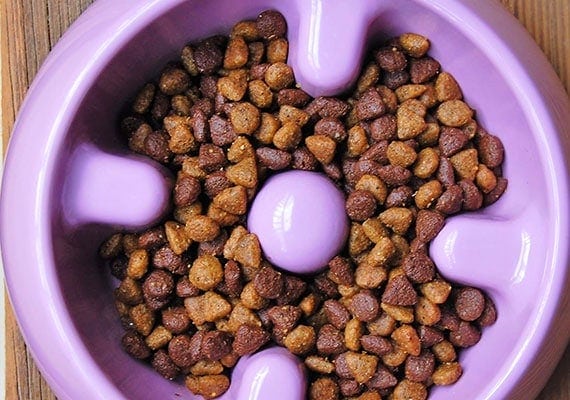
All told, slow-feeder dog bowls come in hundreds of different patterns. While each slow-feed dog bowl may look different, they are all designed to slow any dog who wolfs down their food. That said, some patterns are more suitable for certain breeds than others.
Why Do Dogs Eat Quickly?

Some dogs like to eat very quickly, which can be motivated by a few different things. Sometimes, this behavior starts as a puppy when they compete with their siblings in the litter for food. Some pups feel they are competing with other dogs in the home for food and may feel anxious about it, causing them to gobble their food down very quickly. This is an innate survival instinct.
Many food-motivated breeds like the Golden Retriever, Beagle, Corgi, Pug, Great Danes, and Bulldogs gobble their food up as quickly as they can, without fail.
While sometimes eating too fast is a behavioral issue, other times it can result from an underlying health issue. Canines with invasive parasites may have trouble digesting food and always feel hungry. If you suspect your pup may be eating quickly due to parasites, it is best to check with your vet as soon as possible.
Canine Bloat Is Life Threatening
Dogs who eat too quickly are putting themselves at risk. Gulping down food too fast is dangerous, specifically for larger, deep-chested breeds. Eating too fast can put them at risk for gastric dilation volvulus, also called canine bloat. This condition is life threatening and requires immediate medical treatment.
A good majority of the time, canines eating too quickly is a behavioral issue, and there are methods owners can take to slow them down. Using a dog dish that slows eating is an easy step owners can take that can have a very beneficial impact on their dog’s health in the long term. Along with trying a slow feeding option, owners can also break their dogs’ meals into smaller, more frequent sessions rather than two larger ones.
Best Slow-Feeder Dog Bowls
We spent over 120 hours testing 35 different slow-feed dog bowls with the help of our dedicated doggy testing team.
There are a few distinct types of slow-feeding dog bowls to consider. We’ve picked the best slow-feeder dog bowls based on factors like price, customer reviews, durability, personal experience, and more to help you decide what might work best for you.
There are several different types of slower-feeding pet bowls: stainless steel, ceramic, elevated, puzzle, or maze bowls. All of these have different features and designs but work to accomplish the same goal: getting your dog to pull back on the reins at mealtimes.
Best Overall Winner: Outward Hound Fun Feeder Slo Bowl Review
This popular pick by Outward Hound has a unique design that helps pups reduce a dog’s eating speed up to 10 times. Bowls are uniquely designed with ridges to help lengthen meals and slow down how fast your pup gobbles up that food. These bowls are made to keep them around for a while and also feature a non-slip base. This product also has three different sizes and five styles to choose from, so they work for pups of all different needs. Bowls are easy to clean and safe to put on the top rack of the dishwasher. These start at just $8. You cannot beat the value.

What Our Testers Found
Does the Fun Feeder Slo-Bowl live up to the hype? I can confidently answer that with a solid YES!
- All four styles of the bowl performed well, considerably increasing the amount of time it took our doggy testers to finish their food.
- The non-slip base stopped the bowls from sliding around at mealtime and performed well on all surfaces. Even our most excited dogs were able to eat their meal without food spilling.
- The solid construction becomes particularly apparent when compared with other slow-feed bowls on the market. I was particularly impressed that food-safe plastic is used – no BPA, PVC, or phthalates. I would feel comfortable eating out of this bowl myself if the situation arises!
- Once feeding time is over, the Fun Feeder Slo-Bowl is easily cleaned with a trip through the dishwasher (top rack only!).
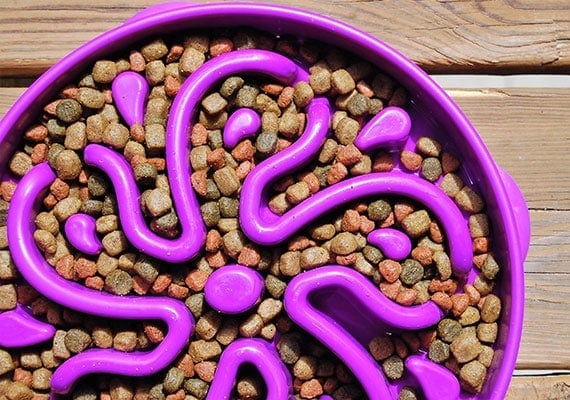
I found that one design, in particular, was suited for the widest range of dogs – big, small, and flat-faced, the purple Outward Hound Fun Feeder bowl. The pattern on the purple bowl featured lower ridges and shallow valleys and was the only style that every dog we tested with could comfortably and confidently eat from. If you have never used a slow feeder before, I highly suggest starting with this one.
| Pros | Cons |
|---|---|
| Reliable and effective | Some pets can flip bowls over if they have the wrong size |
| Multiple sizes and patterns | |
| BPA, PVC, lead, & phthalate-free | |
| Easy to clean and easily portable | |
| Non-slip | |
| Compatible with wet, dry, and fresh foods | |
| Top rack dishwasher-safe |
Pricing
- Starts at $8.47
Best Stainless Steel: Neater Pet Brands Stainless Steel Slow Feed Bowl Review
This is a top choice for owners who prefer a stainless-steel dish to plastic or ceramic and is designed to tamper down rapid eaters and prevent indigestion, overeating, vomiting, and bloat. This one is available in foure different sizes: 3/4 cup, 1 1/2 cups, 3 cups, and 5 cups. There is an option for every breed of canine. Stainless steel is dishwasher safe and non-slip and non-skid.
The bowl is designed to steady the eating rate, and it is not a maze or a toy. This steel does not retain food odors or collect bacteria. Unlike plastic dishes, animals are unable to chew through the steel material.
The only downside to stainless steel slow feeders is that metal is harder to work with than plastic, which means the patterns found on these slow feeders are much simpler than those made from plastic.
| Pros | Cons |
|---|---|
| Sturdy and durable | Does not take as long to eat from as maze or puzzle bowls |
| Dishwasher safe | The non-slip rubber ring can come off |
| Effective at slowing eating down | Not as effective for every pet |
| No-tip design | |
| Chew-proof |
Pricing
- Starts at $16.99
Runner-Up Stainless Steel: Mr. Peanut’s Stainless Steel Interactive Slow Feed Dog Bowl Review

Consider Mr. Peanut’s Stainless Steel Interactive Slow Feed Dog Bowl if you want a second choice for a stainless steel bowl. Mr. Peanut’s is a family-owned business that tests all the products they manufacture on their own dogs. This one is also designed with the input of a veterinarian.
While the design may look simple, the gap between the hump and the sides of the bowl was precisely measured. It is the perfect distance to slow your dog’s feeding time while allowing him access to his food. The non-skid silicone base did what it claimed, preventing our dogs from pushing their bowl across the floor.
| Pros | Cons |
|---|---|
| Shatterproof | Does not take as long to eat from as maze or puzzle bowls |
| Dishwasher safe | Some owners report rusting on the bottom |
| Three sizes | Not as effective for every dog |
| No-tip design good for wet or dry food | |
| Non-slip silicone base |
Pricing
- Starts at $10.99
Best Ceramic Slow Feeder: LE TAUCI Slow Feeder Ceramic Review
Some pet owners prefer a ceramic bowl, which helps prevent canine chin disease (muzzle folliculitis and furunculosis) and the spread of bacteria. Ceramic is nonporous, very easy to wash, and does not hold onto bacteria. Most of the time, it is also very sturdy and heavy, preventing pets from pushing their bowls around the room.
The ceramic bowl is microwave-safe, which is helpful for owners who like to heat their pup’s chow. The sturdy ceramic material is chew-proof and stands up to wear and tear. These are heavy and have a non-slip base, meaning they stay put and do not tip over. There are multiple colors and maze designs to choose from. Learn more about other ceramic dog bowl options in our guide.
| Pros | Cons |
|---|---|
| Ceramic prevents bacteria buildup | Color may come off |
| Durable ceramic material | It may damage the teeth of aggressive eaters |
| Easy to clean | |
| Non-slip design | |
| Slows speed eating down x 10 | |
| Multiple colors and sizes | |
| Chew resistant |
Pricing
- Starts at $26.99
Best Elevated Slow Feeder Dog Bowl: URPOWER 2-In-1 Elevated Review
This raised feeder will help improve digestion and lessen the strain on your pup’s hips and joints. Feeder bowls are designed to be spill-proof and non-slip. It is also adjustable to four different heights, which is quite helpful. This bowl stand can adjust to reach 3.4-inch, 8.1-inch, 9.7-inch, and 11.3-inch heights. This comes with a slowing water feeder designed with a floating disc to tamper down drinking speed and avoid spills, splashing, and choking. The raised design helps reduce stress on the neck joints and spine. This one-piece design is easy to adjust, clean, and store.
| Pros | Cons |
|---|---|
| Large size | Grooves are deep, and some pets cannot reach the food |
| Sturdy | Some owners do not like the floating disk in the water bowl |
| Adjustable heights | |
| Slows down eating and improves digestion | |
| Prolongs eating and drinking |
Pricing
- Starts at $30.99
Best Large Size: Neater Slow Feeder Review
The Neater Slow Feeder comes in a kit allowing you to choose between 5 and 7.5 inches (13 and 19 cm) for your feeding height. You can even remove the legs, which allows you to use this as a regular slow-feed bowl.
Even though this feeder is a larger size, the Neater Slow Feeder could be used by dogs of any size. Best of all, its unique egg-crate design slows down all types of dogs during feeding – even flat-faced dogs!

The large size of the Neater Slow Feeder made the bowl difficult to tip over, and even our overly food-excited yellow Labrador, Tucker, failed to push the bowl around while eating.
However, the larger size had one drawback. At 10 inches long and 15.5 inches wide (25 by 39 cm), this elevated slow feeder might be too large for small dogs. Our Chihuahua tester, Fiona, had to pace back and forth and even climb into the bowl to get her small meal. This is a minor issue, as elevated slow feeders are not aimed at small dogs anyway.
| Pros | Cons |
|---|---|
| Good for all breeds, including large and flat-faced | It may not work for every dog |
| Extra large capacity | Some owners report it is hard to keep clean |
| Can grow with your pet | |
| Made in the U.S.A. | |
| Top rack dishwasher-safe |
Pricing
- Starts at $37.99
Best Puzzle Bowl For Dogs: DR CATCH Puzzle Feeder Review
Some pups do very well with puzzles or maze feeders. Sometimes, these mean the same thing, but there are a couple of distinctly different styles.
This puzzle feeder is designed to make pets work to get their food. It is an interactive and fun puzzle toy that they must solve to find their meals or treats. The puzzle can keep pets entertained for a long time. It works with pets of all ages and provides much-needed mental stimulation. Along with helping your pup calm down faster eating, this challenging toy will help reduce boredom, prevent anxiety, and offer some stress relief.
Owners report that this toy is durable, sturdy, and easy to clean, and pups do not get bored. This is also a fun way to get pets to take medication, as owners can hide the medicine in a treat, which pups then must hunt for. Dogs can maneuver through this puzzle with their noses or paws.
| Pros | Cons |
|---|---|
| Interactive | Some pets figure out quickly |
| Mental stimulation | Too challenging for others |
| Very effective at steadying eating rate | |
| Aids in better digestion |
Pricing
- Starts at $9.99
Best Maze Bowl: 2PET Slow Feed Dog Bowl Review
This maze feeder comes in eight different colors and designs. It works to stop pets from eating too quickly. This helps to prevent vomiting, bloat, choking, and gastrointestinal discomfort. The 2PET maze feeder has a rubberized non-skid bottom and works for most small to medium-sized pups. The medium size holds up to 2 1/2 cups of chow, so it can be used for any size dog.
With every product purchase, the company donates to help needy pets. These maze-shaped bowls keep mealtime fun and nutritious. Bowls will slow down canine eating time by 10%. The product is very easy to clean. It is made from plastic with a silicone grip bottom. It works very well with dogs. Owners even report good results with cats.
| Pros | Cons |
|---|---|
| Holds a little more than some other options | Some dogs can pick up bowls and dump out food |
| Durable | |
| Multiple colors and maze designs | |
| Non-skid bottom | |
| Medium and large size | |
| The maze shape helps prevent vomiting and aids in better digestion |
Pricing
Best Dog Bowl For Fast Eaters: KUNWU SUS304 Stainless Steel Dog Food Slow Feeder Ball Review
Slow feeders are fantastic tools and work well for many dogs. However, they do not work for all dogs. For various reasons, some owners and pups prefer a standard bowl but still need to find a way to reduce their fur baby’s eating rate. This stainless-steel dog food ball can be a wonderful tool for these pups. The polished stainless steel dishwasher-safe ball works for all pups and breeds with fast eating habits. It is heavy-duty, thick, does not rust, cannot break, and lasts a long time.
The ball comes in small, medium, and large options, so there is something for every size of pup. It is a very simple design. Owners place the ball in their pet’s food bowl and then add the food. This is an excellent option if you are still determining how well your pup will do with a puzzle or maze feeder. The simple steel ball is not invasive but very effective at slowing down those gulps.
Our First-Hand Experience With Slow Feeder Balls
“We use this ball with our Cavalier King Charles Spaniel, who loves to gobble up his food quickly. The ball is smooth and slippery, making it difficult for him to remove it from his bowl. The ball forces him to eat around it, making gobbling chow down much harder. He eats much slower with this ball, and I love that we can use our existing dog bowl with it (or on the go with a travel bowl).”
– Sadie Cornelius, Cavalier King Charles Spaniel Parent & Canine Journal Marketing
| Pros | Cons |
|---|---|
| Easy to use and clean | Some owners report only mild results |
| Long-lasting | Not as effective for some dogs |
| Highly effective | |
| Chew Proof | |
| Versatile, works with any standard dog bowl |
Pricing
- Starts at $15.99
How To Pick A Slow Feeder
When it comes to slow feeders, there is no one-size-fits-all option. Dogs are all unique creatures and develop independent habits. Not every fast eater has the same issue, so not every product will work the same for each dog. Make a list of your pup’s eating needs and prioritize the characteristics you are looking for. Once you have considered all your dog’s needs, you can start the research process, look at reviews, and try out a few products. Keep in mind that sometimes owners must try one or two products out before they find the one that works best for their pup.
Frequently Asked Questions
I know there are still plenty of questions about slow feeders and feeding puzzles for dogs. I’ve covered several below, but if I missed yours, let me know in the comments.
Are Slow Feeders Good For Dogs?
Yes, slower feeding tools can benefit pets of all ages. Along with slowing the rate at which they eat and lessening the risk of indigestion, choking, vomiting, and bloat, these interactive feeding methods keep pets mentally active. Instead of rapidly gobbling up their meals in a few moments, they must engage, which can also reduce their stress levels.
Many vets will suggest slower feeding methods if canines have anxiety, eat too fast, or are food-guarding. Larger breeds, in particular, do well with these, as they have a higher risk of bloat. However, these are beneficial to any size or breed of canine.
Will My Dog Get Enough To Eat From A Slow Feeding Bowl?
Yes, your pup will get the right amount of food. It will simply take longer to eat. As owners, we are in control of how much kibble goes into the feeder. Therefore, you can monitor how much they eat, add more if they are having trouble getting it all out, and better control the amount they eat.
Are Slow Feeders Frustrating For Dogs?
Sometimes, puzzle and maze feeders can be frustrating for dogs. This is why it is essential to do your research and pick a suitable size bowl made of high-quality, pet-safe materials. Bowls that are too small can increase frustration and anxiety as it may be tough, if not impossible, for dogs to get the food out. You do not want to introduce anything that will make feeding time more stressful, so ensure you have gotten the right size for your pup.
More About Feeding Dogs With An Insatiable Appetite
Some dogs, like Labradors, have a higher genetic risk than others for obesity. This article details the research and shares some tips on dealing with dogs with an insatiable appetite.
Our Testing Process
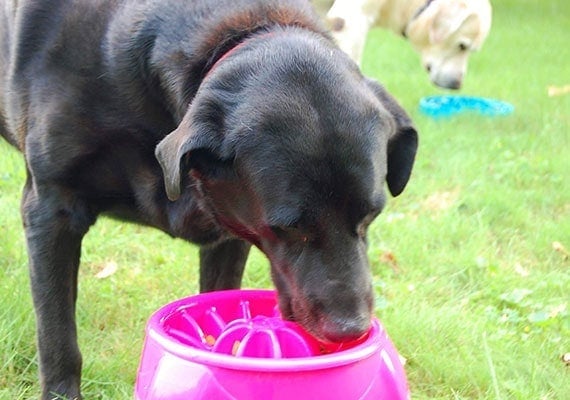
At Canine Journal, we take our reviews seriously. We never recommend a product without thoroughly testing it first. By the end of the process, we spent 120+ hours researching, testing, and reviewing the most popular (and even some unpopular) slow-feed bowls on the market.
No dogs were overfed or starved during our testing process. But rather, they seemed to enjoy the entire process. Who could blame them? Cuddles and food? That would be anyone’s dream job.
Two different sizes of kibble were used during testing – one for small dogs and the other for medium to large.

- Over multiple feeding sessions, we timed how long it took our team of dog testers to eat ¼ cup of dry food from a regular dog bowl. Why a quarter? Well, we had a lot of bowls to get through, and we didn’t want to overfeed our dogs.
- But don’t worry – once we narrowed down our top picks, each bowl was rigorously tested with full-sized meals. The time started with the dog’s first bite and stopped once the last piece of kibble entered the dog’s mouth.
- We then compared this with the time it took to eat from each slow feeder on this list. Again, we did this over multiple meals. The slow-feeder bowls that extended our dogs’ eating by the largest amount of time were the winners.
Surfaces Tested
We tested each slow-feed bowl across four different surfaces:
- Tile flooring
- Wood decking
- Concrete
- Grass
The winners were slow-feed bowls that moved less than 2 inches on all four feeding surfaces. Any bowl that was upended on three or more occasions was given an instant fail. None of our top picks were upended during testing.
It is worth mentioning that no bowl could be called spill-proof when used on grass. Because grass has a certain amount of give, larger dogs could squeeze a paw or nose under the bowl and flip it.
When you first introduce your dog to a slow feeder, I recommend doing so on a hard, flat surface.
Further Testing Observations
1. Wet And Raw Food

Slow-feed bowls are most commonly used with dry food. With that said, we also wanted to test their performance with wet and raw foods.
- For our wet food test, we used Rachel Ray Nutrish Wet Dog Food.
- And for the raw food, liver and kidneys came from the local butcher.
I found that the more complicated the feeder, the worse it performed with wet and raw dog food.
For starters, it required a spoon to mash the food into the gaps of the maze. If you skipped this step, the food would sit awkwardly on top of the bowl – which didn’t slow down mealtime.
When it came to wet food, the simpler slow feeders outperformed those with more complex mazes. Stainless steel and ceramic bowls with a hump were the easiest to fill with wet or raw food while providing enough of a challenge to slow down our fast-eating dogs.
2. Ease Of Cleaning
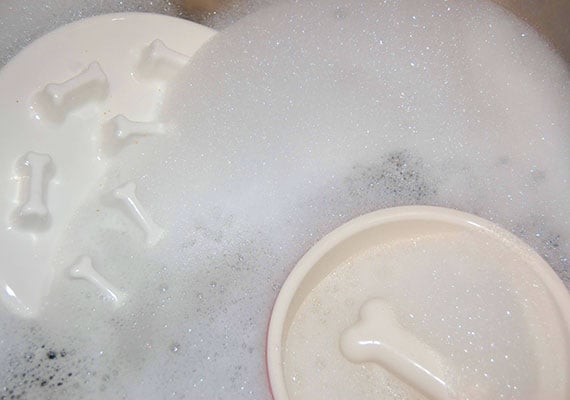
It goes without saying that slow-feeder bowls are more challenging to clean than your regular dog bowl, especially when used with wet or raw dog food. You know those dried-up specks of food that refuse to come off your dog’s bowl? Well, imagine adding a maze of swirls, bumps, and crevices for the food to get stuck in.
Fortunately, most slow-feed bowls we tested are top-rack dishwasher safe. All our top picks will survive in your dishwasher. Slow feeders made from ceramic proved to be the trickiest to clean – the leftover dog food just didn’t want to let go.
Fortunately, a quick soak in hot, soapy water was all it took to loosen the caked-on dog food. A brief hand wash later, and the bowls looked as good as new. For those who are everyday cleaners and prefer wet food, I recommend choosing a slow feeder made from any material except ceramic. We cover how to clean your dog bowl in more detail here.
Meet Our Canine Testers
Now that you know what and how we tested, it’s time to introduce you to those who tested the slow-feed dog bowls.
We had seven canine team members to test our collection of slow feeders.
Let me introduce you…
1. Harper
Breed: German Shepherd and Border Collie mix
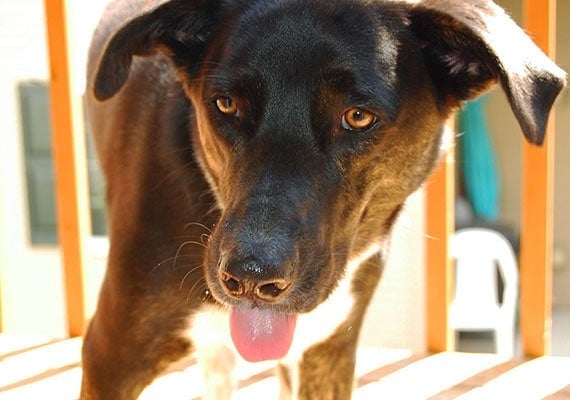
Don’t be fooled by her size! Harper is a puppy at heart. She enjoys ruining the toys of the children who live with her and chasing the vacuum cleaner. She is afraid of umbrellas and roller skates.
2. Lucy
Breed: Bernese Mountain Dog
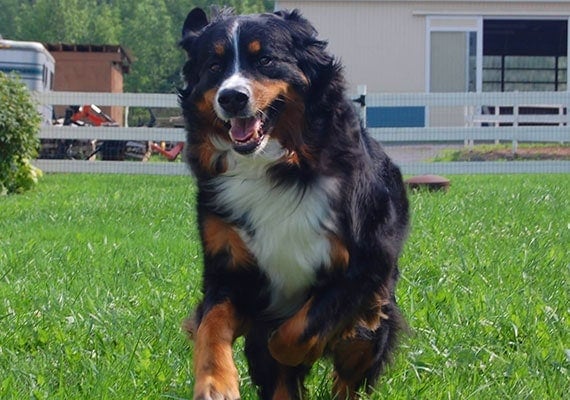
Lucy is never sad. She lives on a horse farm and is quite convinced that she actually is a horse. She enjoys pizza crust and galloping around the yard, doing her best imitation of a horse.
3. Chloe
Breed: Pit Bull Mix
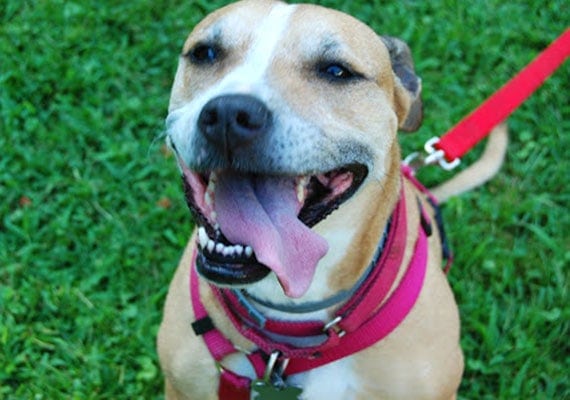
Chloe is always smiling and getting into mischief. She loves belly rubs, chasing the four-wheeler, and tries to devour Fiona (our next tester) whenever she gets a chance.
4. Fiona
Breed: Chihuahua
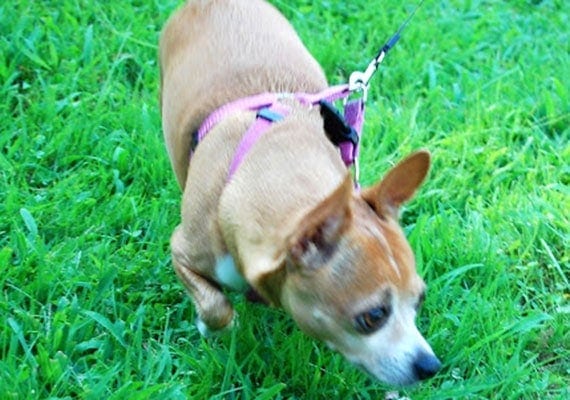
The tiniest of our testers, Fiona, is a little snuggler. She loves barking and hates looking at cameras. She is skilled at avoiding Chloe’s attempts to eat her.
5. Tucker
Breed: Yellow Labrador Retriever
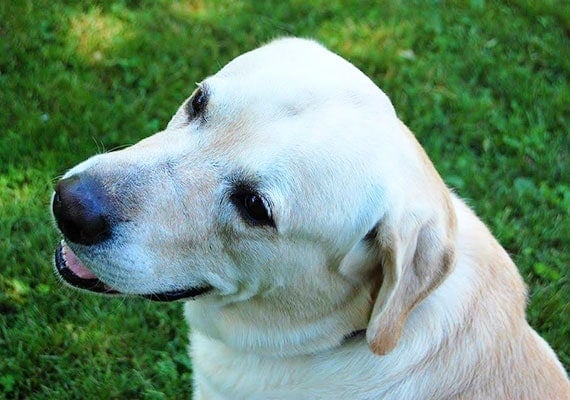
Weighing in at 130 pounds, Tucker is a monster for his breed. He enjoys begging and letting the dogs down the street through the front door.
6. Cooper
Breed: Black Labrador Retriever
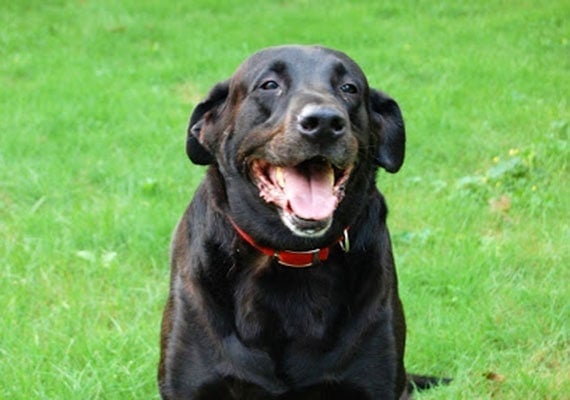
Cooper is a tad overweight and dangerously friendly toward anyone with food. He likes stealing frying pans off the stove and getting into cars with people he doesn’t know.
7. Olivia
Breed: Valley Bulldog

Also, answers to Liv. She enjoys beach vacations and the dog park. She loves to wiggle and is always happy, even if you can’t tell. This is her happy face!
Alternatives To Slow-Feed Bowls
If you don’t want to spend your money on another bowl for your dog, then why not try one of these tricks to slow down your dog’s mealtime?
Full disclosure: We didn’t have much success with any method. But that doesn’t mean you won’t. As for me? I’m sticking with a slow-feed bowl.
1. Use Your Yard
It turns out that the answer to your getting your dog to eat slower is below your feet. Sprinkle kibble around your yard, and your dog will have to spend time finding it. During testing, we discovered two drawbacks to this method. First, it’s not suitable for wet food. But the biggest problem comes when your dog doesn’t find every last piece of kibble. Any uneaten food invites unwanted guests, such as raccoons and squirrels, to set up home in your yard.
2. Use A Muffin Pan
This was the most common advice I came across when researching how to get a dog to eat slower without buying a slow-feed bowl. It seems simple enough. Fill each cup with a small amount of dog food and give it to your dog.
Unfortunately, it’s also the method that I had the least success with. Maybe it was just my muffin pans, but all dogs – large and small – were able to tip and spill their food when they placed a foot on the edge of the pan.
3. Place A Tennis Ball In Your Dog’s Regular Bowl
By placing a tennis ball in your dog’s bowl, your dog will be forced to eat around it, slowing down his mealtime. While this slowed down smaller testers, larger breeds could remove the ball from the bowl – either by accident or on purpose.
However, if you decide to skip the slow-feed bowl, then this is my next best recommendation. It added the most difficulty to mealtime without making a mess.
Wondering What To Put In Your Dog’s Bowl?
Picking the perfect pet bowl or slow feeder is only the first part of the process of providing your pup with complete and healthy nutrition. It is always a good idea to periodically reevaluate what you are feeding your dog. There are many different options on the market, which are only growing. All natural, holistic, grain-free, raw, human-grade, and freeze-dried products are all increasing in availability. Transitioning a pup to a new food is a big deal and not something that should be done at the same time as introducing a slowing feeder. However, periodic reevaluation of what you feed your pup is simply part of being a responsible pet owner. Regardless of the bowl, slow feeder, and food you choose, make sure to keep food stored securely, keep trash cans closed, and keep those bowls fresh and clean.
Why Trust Canine Journal?
Danielle has shared a special bond with dogs since childhood. She has over 30 years of experience with dogs of all sizes and dogs with special needs. Danielle is a dedicated professional researcher and pet product reviewer. She spends countless hours researching the latest pet care, health, food, and training developments to help owners learn what’s behind the label. Her two dogs, Daisy and Falkor, serve as in-house food and product testers, and together, they have tested hundreds of pet products. Danielle works with a professional and experienced team to bring the best, most accurate, and most up-to-date information to our readers.
